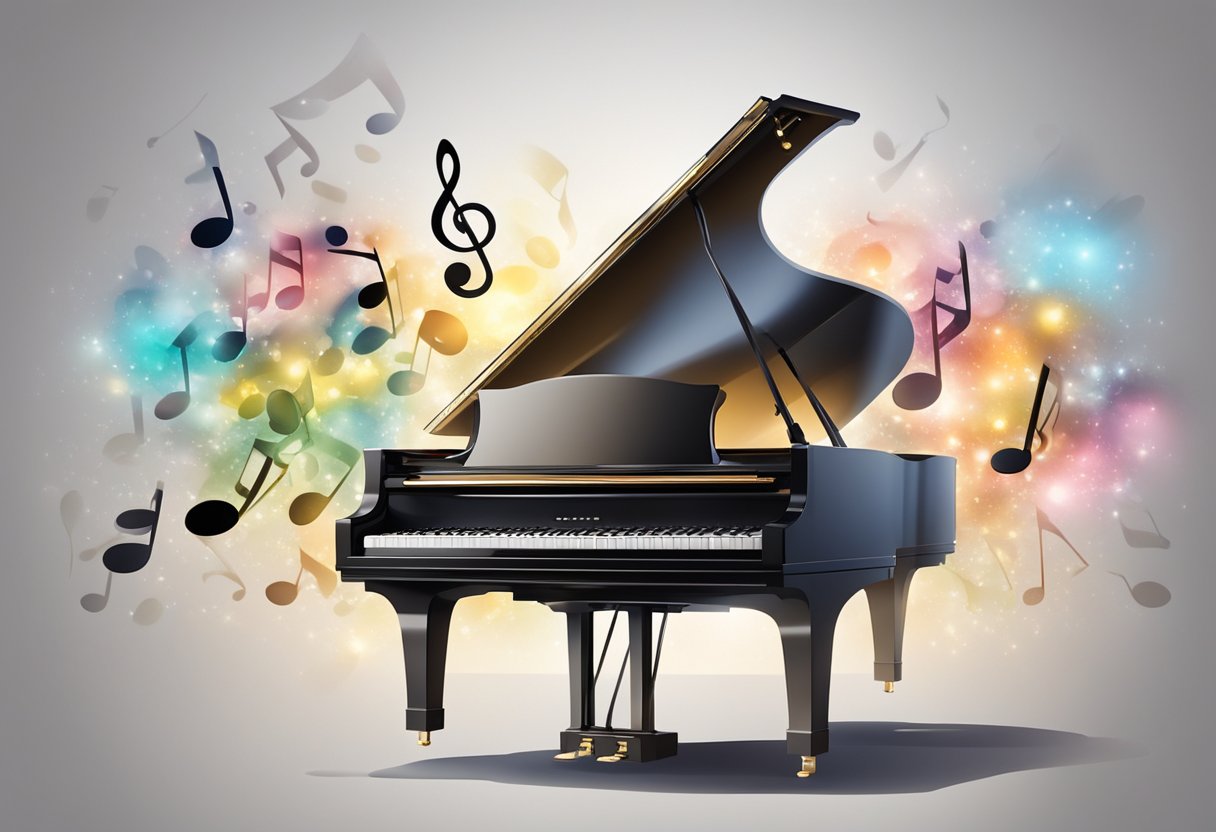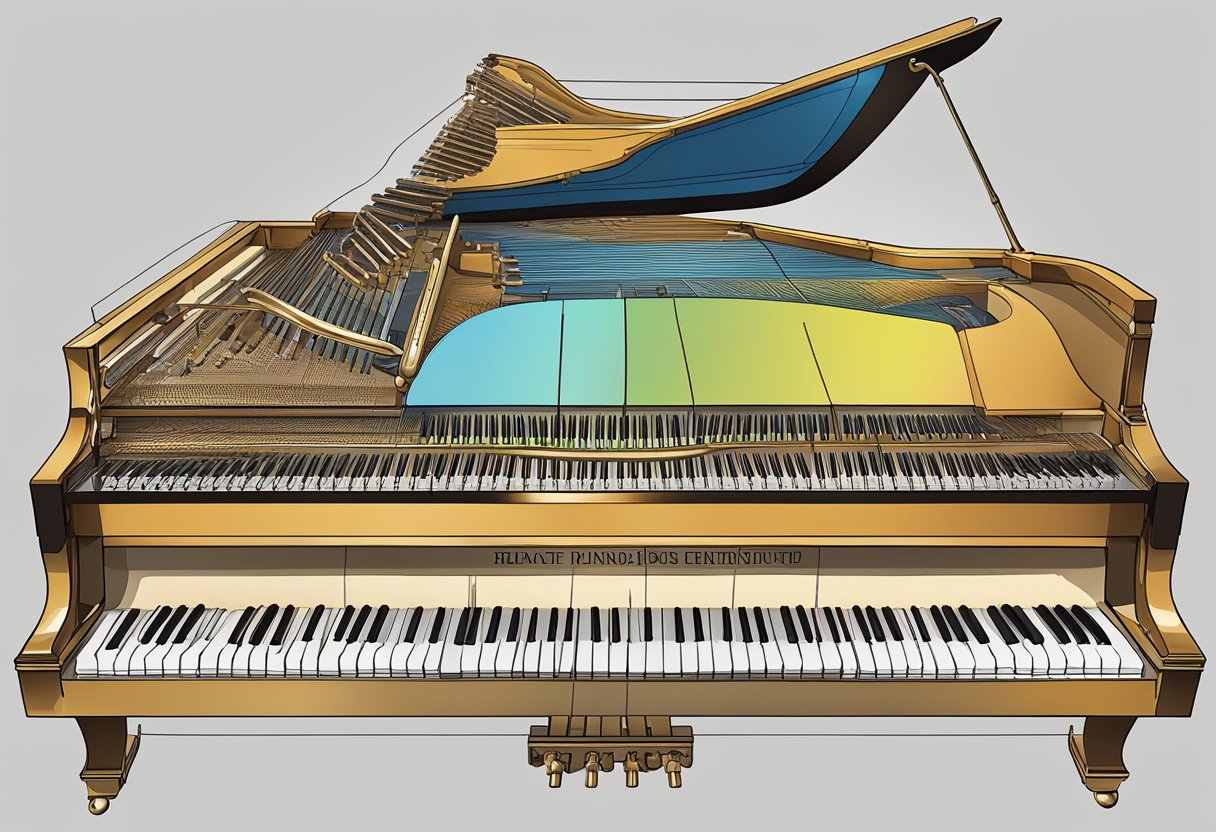As an Amazon Associate I earn from qualifying purchases.
Pianos have pedals to enhance and modify the sound you produce, giving you the ability to add depth and emotion to your playing. On a modern piano, typically a grand or an upright, you’ll find two to three pedals, each serving a distinct purpose.
For instance, pressing the far-right pedal, known as the sustain pedal, allows notes to resonate after your fingers leave the keys, while the left pedal, called the una corda or soft pedal, softens the tone and volume.
Want to Learn Piano?Click Here

When you play a grand piano, you have the ability to sustain selected notes while leaving others unaffected by using the middle sostenuto pedal, a feature not found on many upright pianos.
In some upright pianos, a practice pedal may replace the sostenuto pedal, used to mute the sound for quiet practice. In my own experience as a music teacher, I’ve seen students’ expression transform once they master the pedals – it’s like watching a painter discover a new palette of colors.
The pedals on digital pianos aim to replicate these effects electronically, offering a practical solution for volume and sound control in smaller or sound-sensitive spaces.
While acoustic pianos provide a nuanced control through physical interaction with the strings and dampers, quality digital pianos strive to mimic this experience.
History of Piano Pedals

From the earliest days to the complex systems of today, pedals have transformed the way pianos are played and heard.
Bartolomeo Cristofori and Early Innovations
Bartolomeo Cristofori, the inventor of the piano, introduced the first mechanism to modify the instrument’s tone around 1722. This precursor to modern pedals was a hand-operated stop that allowed players to change the timbre of the notes by modifying the interaction of the hammers and strings
. Cristofori’s early innovation paved the way for what we now recognize as the soft pedal, or una corda, which on grand pianos shifts the action so hammers strike fewer strings, historically one (una corda) instead of three (tre corde).
Development of the Modern Pedal System
Throughout the 19th century, piano makers experimented with various pedal configurations. As the century progressed, a standard design emerged primarily on grand pianos with three pedals:
- The Soft Pedal (una corda): Softens the sound by shifting the keyboard action to make the hammers hit fewer strings.
- The Sostenuto Pedal: Sustains selected notes, allowing them to ring out while others are played staccato.
- The Sustain Pedal (damper pedal): Lifts all the dampers, allowing all struck notes to resonate freely.
This configuration was also adopted in upright pianos, with some mechanical adjustments due to the vertical construction.
Evolution of Pedal Usage in Compositions
Composers like Beethoven and Mozart understood the expressive potential of the available pedals in their time, even when the options were limited.
As the pedal system evolved, so too did their use in compositions. For example, composers like Debussy utilized the sustain pedal to create a wash of overtones in pieces like “Clair de Lune,” giving an ethereal quality to the music.
This evolution empowered musicians to explore new dynamics and sustain notes in a way that had not been possible before, changing the musical landscape significantly.
As you sit before a piano, the nuances of pedal usage become a journey of discovery. Each pedal invites you to explore different soundscapes, from the subtle shifts of the una corda to the grand resonance enabled by the damper pedal. Welcome to the intricate dance of your feet and fingers that brings life to the music you create.
Types of Piano Pedals
When you sit at a piano, your feet have as much a role in the music you’re creating as your fingers. Let’s explore the pedals you’ll find on a piano, each with a unique contribution to your playing dynamics and expression.
Sustain Pedal (Right Pedal)
The sustain pedal, or the right pedal, is the most frequently used pedal on a piano. When you press this pedal, it lifts all the dampers off the strings, allowing them to vibrate freely.
This action prolongs the sound without you having to keep the keys depressed, creating a legato effect that adds depth and resonance to your music. For example, during a dreamy Chopin nocturne, using the sustain pedal helps to blend the harmonies beautifully.
Una Corda Pedal (Left Pedal)
Originating from the Italian term for “one string,” the una corda pedal or simply the left pedal, shifts the piano’s action so the hammers only strike one or two strings instead of three.
This results in a softer and mellower sound. It’s like the whisper of the piano world, bringing a subtle shade to your softer passages. Remember, this is not merely a volume control but a color changer.
Sostenuto Pedal (Middle Pedal)
The sostenuto pedal, found as the middle pedal on many grand pianos, acts as a selective sustain pedal. It holds only the notes that are being held down when the pedal is pressed, allowing the rest of the notes played afterwards to remain unaffected.
This pedal provides you with precision sustain control, perfect for complex pieces where you only want certain notes to linger.
Specialty and Rare Pedals
Some pianos offer specialty and rare pedals beyond the standard three. The fourth pedal, for instance, found on some grand pianos, can offer a variety of effects, such as bringing the hammers closer to the strings for a reduced volume without altering the tone, much like the una corda pedal.
Another rare variant is the celeste or practice pedal, which inserts a layer of felt between the hammers and strings to significantly lower the volume for quiet practice. Notably, these pedals offer pianists a wider palette of aural colors and dynamic control.
Hello & thanks for stopping by! I’m a professional concert pianist and piano instructor. In the United States, I’ve given successful performances in several places including New York, Florida, Connecticut, & New Jersey, I have also performed internationally in Italy and made my Carnegie Hall debut in 2014. I enjoy blogging about the piano, the art of performance, general music, current events and the latest in music production.
